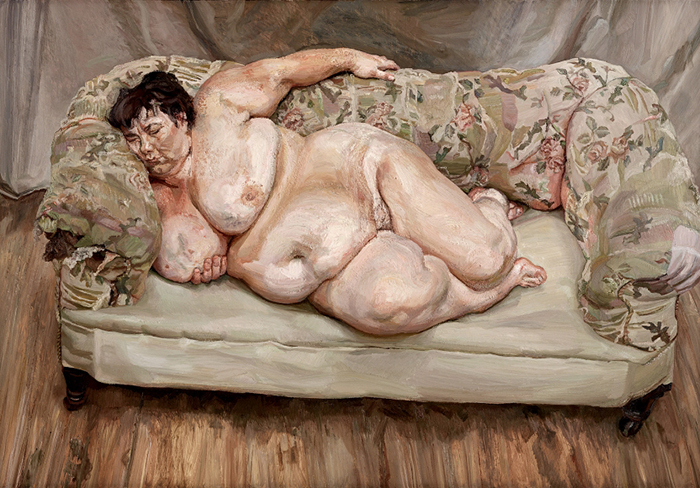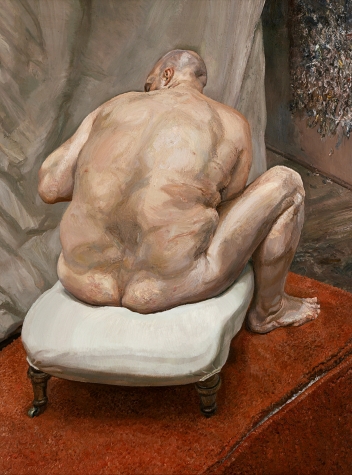CulBeat Express
2019.04.04 17:27
루시안 프로이드 벌거벗은 육신들@아쿠아벨라 갤러리(4/5-5/24)
조회 수 1937 댓글 0
Lucian Freud: Monumental
APRIL 5 - MAY 24, 2019
Acquavella Galleries

Lucian Freud, Benefits Supervisor Sleeping, 1995, Oil on canvas, 59 5/8 x 86 inches, Private Collection
*2015년 5620만 달러에 낙찰, 루시안 프로이드 경매 최고가 기록
(New York, NY, January 22, 2019) — Acquavella Galleries is pleased to present Lucian Freud: Monumental, a loan exhibition focusing on the artist’s naked portraits, a subject that has long enjoyed special significance in his oeuvre. Curated by the artist’s longtime studio assistant and friend, David Dawson, Monumental will include thirteen major paintings, including depictions of his most important models from the 1990s and 2000s.
The exhibition begins with work from 1990, when Freud began painting the performance artist Leigh Bowery, who is featured here in two works. Inspired by Bowery’s impressive physique, Freud began working on a larger scale that emphasized the physical presence of his subjects. These large-scale portraits ushered in a new sense of monumentality in the artist’s body of work. Also on view is Benefits Supervisor Sleeping, one of two paintings in the show from the mid-1990s of Sue Tilley, the other essential model from this pivotal time in Freud’s career. Dawson himself as well as Freud’s familiar whippets also make multiple appearances in paintings in the exhibition.

Lucian Freud, Naked Man, Back View, 1991-92, Oil on canvas, 72 x 54 inches, Metropolitan Museum of Art
Despite the grand scale, Freud’s subjects are depicted with a sense of intimacy, penetrating honesty and psychological depth. This was due in part to the extraordinary amount of time the artist spent with his sitters. Ria, Naked Portrait required the art handler Ria Kirby, whom Freud met while installing a show at the Victoria & Albert Museum, to come to the studio nearly every day for 16 months in 2006 and 2007.
Being naked has to do with making a more complete portrait, a naked body is somehow more permanent, more factual…. When someone is naked there is in effect nothing to be hidden. Not everyone wants to be that honest about themselves, that means I feel an obligation to be equally honest in how I represent them. It is a matter of responsibility, in a way I don’t want the painting to come from me, I want it to come from them. It can be extraordinary how much you can learn from someone by looking very carefully at them without judgement. — Lucian Freud
The show includes important loans from the Metropolitan Museum of Art in New York, the Art Institute of Chicago, The Lewis Collection, in addition to other private collections.
This will be the sixth solo exhibition over the course of Acquavella Galleries’ longstanding relationship with Freud and, since the artist’s death in 2011, his estate. The exhibition will be accompanied by a fully illustrated catalog featuring essays by Dawson and Michael Auping, longtime chief curator at the Modern Art Museum of Fort Worth, who interviewed Freud between May 2009 and January 2011.
David Dawson was Lucian Freud’s assistant from 1991 through 2011, and he is now director of the Lucian Freud Archive. He co-edited last year’s two-volume survey of the artist’s work published by Phaidon. He is currently preparing an exhibition of Freud’s self-portraits for the Royal Academy, London, in October. Dawson also continues to work as a painter in his own right.
Lucian Freud (1922–2011) was one of the most significant painters from the postwar period through the first decade of this century. A grandson of Sigmund Freud, he was born in Berlin and moved with his family to London in 1931. He served in the British navy during World War II, and immediately after began working full time as a painter. Committed to figurative painting for the entirety of his career, Freud built a formidable reputation as a painter of portraiture.
The work of Lucian Freud is represented in major private and public collections worldwide, including the Metropolitan Museum of Art and the Museum of Modern Art in New York; the Hirshhorn Museum and Sculpture Garden and the Smithsonian Institution, Washington, D.C.; and the Art Institute of Chicago as well as the Tate and National Picture Gallery in London; Centre Pompidou, Paris; and Museo Thyssen Bornemisza, Madrid; among many others.






